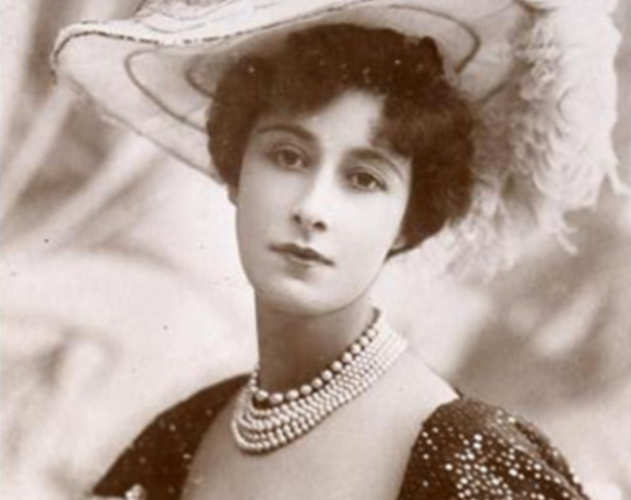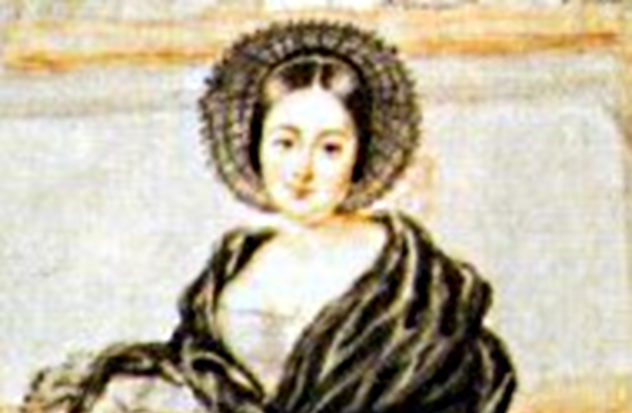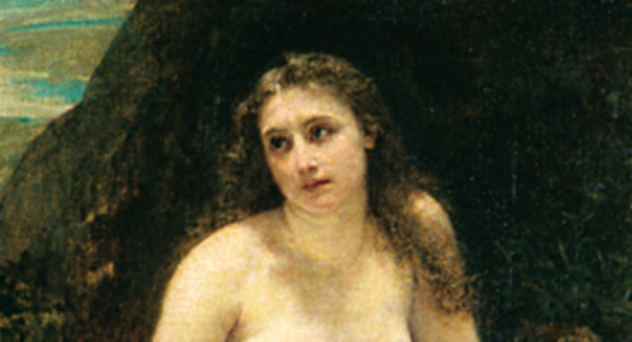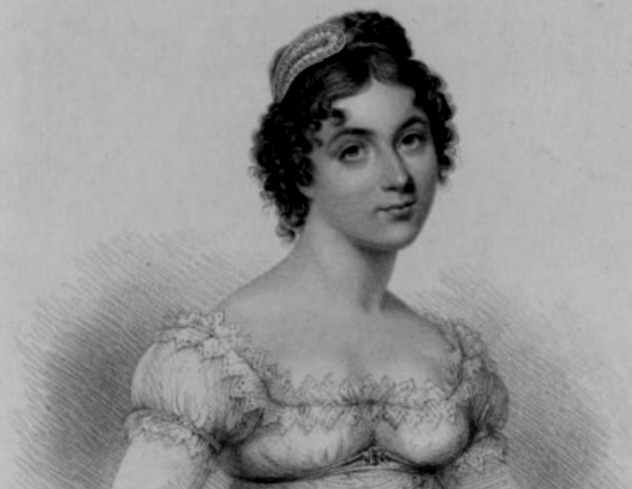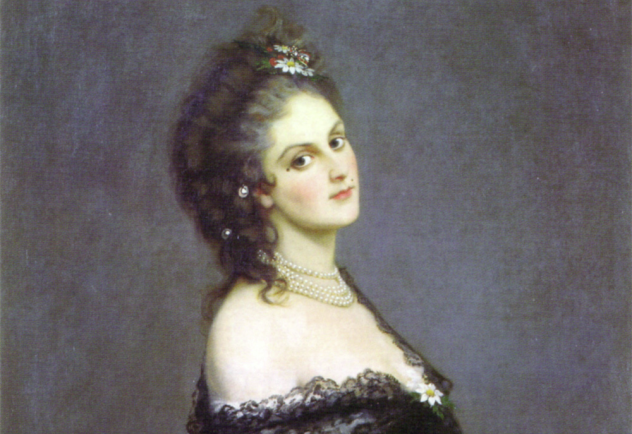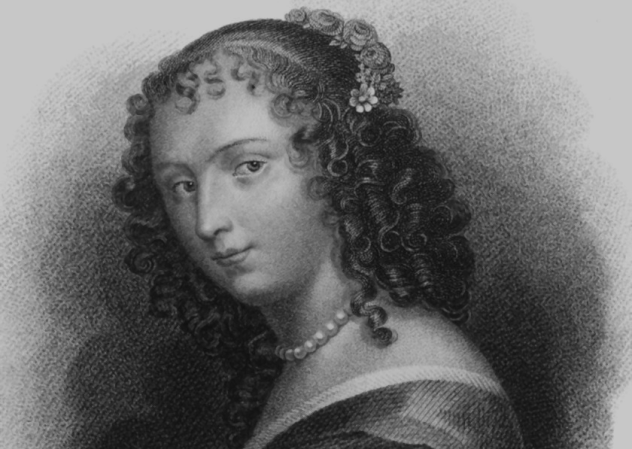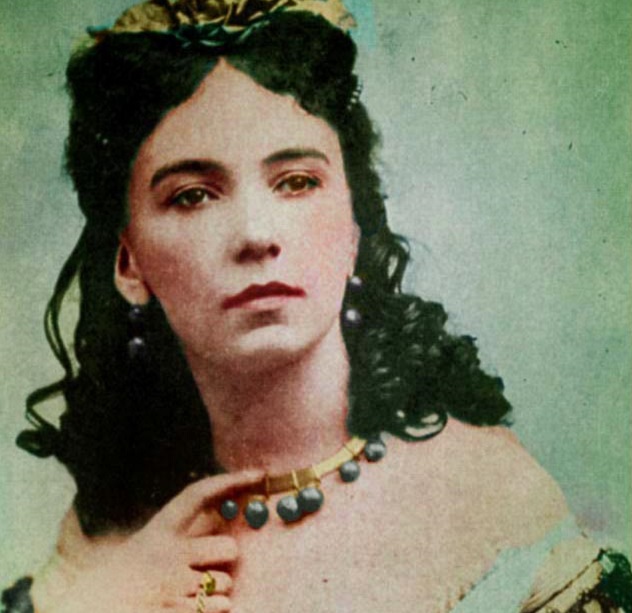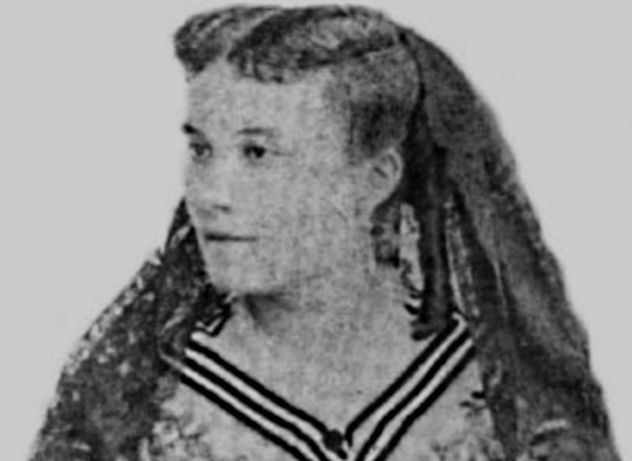In the 16th century, courtesans became a symbol of sexual liberty, beauty, and audacity. Scandal was their middle name, but one cannot compare them with the average light-skirt. Living in decadence, these temptresses were no victims. As a matter of fact, they often sacrificed their lovers in the name of lust and financial gain. These ambitious, manipulative, and shrewd high-flyers were experienced social climbers. Courtesans charged for their love by the hour; it was business first and pleasure later. Mistresses, on the other hand, gave away their love willingly, while a courtesan in love could no longer call herself a courtesan.
10 Liane De Pougy: Notre Courtisane Nationale
Known for having danced at Folies-Bergere and at the courts of St. Petersburg, Liane de Pugy was a Belle Epoque courtesan and a bisexual whose openness toward her sexual ambitions thrilled 19th-century French society. Born Anne Marie Chassaigne in 1870, she was raised in a convent from which she managed to escape via marriage at age 16. In her memoirs, she accused her husband of having abused her. Whether it is true or not, what is certain is that she found consolation in the hands of another man, Marquis Charles de MacMahon. Her husband accidentally walked in on them and shot at them both but only managed to scratch Liane. It was the moment she was waiting for; she abandoned her husband and son by him and never looked back. Aged 18, she began her career as a French courtesan and ensured her place at Folies Bergere when she asked the Prince of Wales to attend her debut. Liane was not afraid to show off her assets and took great pride in her skills. Her honesty and elegance earned her the name of notre courtisane nationale (our national courtesan). In 1899, she started an affair with US female writer Natalie Clifford Barney. Liane wrote about the relationship in her book, Idylle Saphique, describing Natalie as the love of her life. The two made no effort to keep the affair private, and it wasn’t long before it became the most delicious gossip in Paris. As Liane grew older, she got involved in longer-lasting relationships. In 1920, Liane married a Romanian prince, George Ghika, continuing her bisexual affairs to spice things up. To end her career, she returned to the nunnery, where she helped children with birth defects.
9 La Barucci: The Real-Life Venus De Milo
In 1867, the Prince of Wales and future King Edward VII was a young rascal curious to see if all the stories about French courtesans were true. He would not be disappointed. One lady in particular drew his attention, so he made arrangements to meet her. She had been advised to behave with decency, but she knew better. After arriving 45 minutes late (not by accident), she was introduced to the already infuriated prince. Immediately, she dropped her velvet robe to the ground to reveal her most prized possessions. Reprimanded, she simply replied. “What, did you not tell me to behave properly to His Royal Highness? I showed him the best I have, and it was free!” This courtesan was Giulia Beneni, better known as La Barucci. Giulia once told an army colonel that she would only sleep with him if he would parade naked in front of her house, which he did, riding a horse at the head of his troops. Her Italian charm, determination, and childlike spontaneity won her the hearts of many men. She presented herself as the real-life Venus de Milo and even called herself “the greatest whore in the world.” Giulia lived in luxury in a palatial mansion on Champs-Elysees, where she owned a jewelry cabinet worth millions. She kept her visiting cards in a china bowl by the fireplace, which is said to have contained the names of just about every man in high society at the time. After her death, Giulia’s brother blackmailed the Prince of Wales, extorting 6,000 francs in exchange for the compromising love letters between the two.
8 Veronica Franco: The Fiercely Independent Courtesan
In 16th-century Venice, a young, well-educated woman caused quite a stir among noblemen at high courts. The daughter of adored Venetian courtesan Paola Fracassa, the profession ran through her veins. Veronica Franco was born in 1546; her mother taught her the trade. Her brothers provided excellent education in Greek and Latin, and she played the lute, all imperative skills if she were to succeed in her pursuits. In the early 1560s, she married Paolo Panizzo. It was an unhappy marriage, and the couple soon separated. Veronica asked her dowry to be returned to her. From then on, she became an independent woman who supported herself and her six children by different men. She mastered the art of lovemaking and charged a pretty penny for it, too. Rich men became her protectors, offering her a life of luxury and decadence. Among them was Domenico Venier, who held the most influential literary salons in 16th-century Venice. She had an affair with King Henri III of France and painter Jacopo Tintoretto and was often found wandering around privileged circles of politicians, poets, artists, and philosophers. She eventually gave up courtesanship, and it is said that she later regretted the choices she had made. She retired into literature and wrote two volumes of poetry: Terze rime and Lettere familiari a diversi, the latter being a collection of 50 love letters she wrote to her lovers, including Henri III of France. During the plague, Veronica left Venice only to return and find her home plundered by thieves. She was accused of witchcraft and immorality by the Inquisition court, but the charges were dropped after one of her patrons came to her aid. Losing her fortune, she slowly descended into poverty and died in a ruined part of the city at age 45. Her life story is depicted in the 1998 movie Dangerous Beauty.
7 Marie Duplessis: The Lady Of The Camellias
It’s a typical day in 19th-century France. A young man with a modest income and a good education meets a beautiful woman, courted by the majority of Paris’s aristocracy, known as The Lady of the Camellias. Marie Duplessis was born in 1824 from a poor family and was forced to beg on the streets from a young age. Her father thought it best to put her beauty to good use and sold her to an elderly man, with whom she lived, when she was only 14. By the time she was 16 and working as a seamstress, she realized there was much to gain if she accompanied wealthy men, both in the bedroom and in high society. She started off as a mistress to young students and was initiated in courtesanship by Duc de Guiche. Marie was a petite woman with an enchanting smile and a great sense for fashion and elegance. Her candor made her even more attractive. Despite her humble background, she educated herself and owned as many as 200 books in her personal library. Her wits and ambition propelled her to the courts of Paris, where she became one of the greatest 19th-century French courtesans. Throughout 1844, Count de Stackelberg was her sugar daddy, a wealthy man much older than Marie who took a fancy to her because she reminded him of his departed daughter. Around 1845, she met Franz Liszt, who gave her piano lessons, both literally and figuratively speaking. By this time, she was already ill with consumption, also known as tuberculosis. Marie was a heavy spender who knew how to take a hold of the little time she had on this Earth and live life at its fullest; it’s as if she knew that tuberculosis would claim her life at age 23. Charles Dickens himself attended the lavish funeral along with the cream of French society at the time. Alexandre Dumas, whom she’d met in 1844, was completely smitten with her. Although the affair barely lasted a year, he immortalized young Marie in his novel, La Dame aux Camillas, published six months after her death. Dumas turned his book into a play. On the opening night, Giuseppe Verdi stood in the audience. Moved by the story, he wrote La Traviata.
6 Blanche D’Antigny: Emile Zola’s Nana
In 1880, Emile Zola published a controversial novel about a French courtesan who lacked brains and charm but could draw her men into a dangerous and sticky web that would ultimately lead to financial ruin. The novel was called Nana, and Zola portrays the titular character as a wicked human animal, destroying everyone and everything around her. Marie-Ernestine Antigny was born in 1840, worked as a part-time actress and singer, and certainly fits Zola’s description, which is why it is widely believed that she was the inspiration behind the novel. Her physique, her attitude toward men, her clawing her way through high society, and her painful death at a young age make her a perfect match. Blanche’s life was indeed eventful enough to inspire such a novel. When she was only 14, she left a convent and traveled to Romania with an aristocrat, returned to Paris, joined a circus, and then traveled to St. Petersburg alongside a Russian police chief. In reality, Blanche wasn’t as morally indifferent as Zola’s Nana. She did rise from being a streetwalker to entertaining some of the most influential men in Paris, and it is said that her total number of lovers defies calculation. However, Zola never even met her, and he wrote his story after her death. Blanche did indeed have a taste for extravagance, throwing lavish parties and making public appearances draped in diamonds, but perhaps one of her greatest charms, not mentioned in the book, was her gullibility. After making love, she would fall into such a heavy sleep that her lovers could simply leave her bed without compensating her. Later in life, she fell madly in love with a poor tenor by the name of Luce and left her wealthy sugar daddy to be with him. She was faithful to Luce for two years until he died of tuberculosis, during which time she lost her fortune and was forced to live in modesty. She contracted consumption herself and died aged 34, all alone, just like Zola’s Nana.
5 Harriette Wilson: The Revenge Of A Courtesan
In 1825, London’s high society was facing a serious menace. King George IV and his mistress (Lady Conyngham), the Duke of Wellington (who defeated Napoleon at Waterloo), and 200 other noblemen were threatened with exposure in Harriette Wilson’s soon-to-be-published memoirs unless they paid up. She managed to bring British aristocracy to its knees. Harriette wrote, “I shall not say why and how I became, at the age of 15, the mistress of the Earl of Craven.” The daughter of a Swiss clockmaker, Harriette became a prostitute at 12 and a courtesan at 15, after being seduced by the Earl of Craven. The skill ran in the family; both her sisters were courtesans. She entertained her men at the opera, surrounded by statesmen, aristocrats, poets, national heroes, and students. She was both talented in bed and financially. Harriette’s sugar daddies were some of the most distinguished men of the time. The Duke of Wellington, Lord Palmerston, and Lord Byron often shared her bed, and she had a longer-lasting affair with the Duke of Argyle. Harriette had a distinctive operating mode: She would choose a mark and write a passionate letter to lure him. Once the two became lovers, she would try to blackmail her lover. In her mid thirties, she retired from courtesanship and began writing her memoirs. It was yet another business deal. Together with her publisher, Joseph Stockdale, she contacted 200 of her former lovers, presenting them with two choices: either pay up or they’d be granted a special chapter in her book. It was the cold revenge of a courtesan. In her memoirs, she revised her chapters depending on how much her former lovers paid for her discretion. For a fat sum, she even offered to depict them in the most favorable light.
4 Countess Castiglione: The 19th-Century Narcissist
When the Kingdom of Italy was proclaimed in 1861, part of it was owed to one woman’s extraordinary influence and manipulative powers. Virginia Oldoini was a ravenous beauty with long brown hair and blue eyes. Born of noble parents in 1837, she received an excellent education and could speak several languages. At 16, she became mistress to naval officer Marquis Doria. One year later, her parents threw her into an arranged marriage with Count Castiglione. She had a child by him, but she was nowhere near the obedient, faithful wife he had hoped for. It wasn’t long before she drew the attention of the Italian government, who required her assistance in the Unification of Italy Movement by acting as a spy. In her mission, she seduced Louis Napoleon, the French emperor, and was quite the sensation at the French court. Johann Strauss once stopped a recital because he was stunned by her beauty when she entered the room. She convinced Napoleon III that Italy should be united; the Kingdom of Italy was proclaimed four years later. Upon returning home, Virginia started an affair with none other than Victor Emmanuel II, the Italian king. He gave her a nice apartment in Florence’s lavish Pitti Palace and set her up with a sizable pension. Her string of lovers did not end there; Richard Seymour Conway offered one million francs for 12 hours in her company. Countess Castiglione, as she liked to be called, has a legacy that goes far beyond her courtesan skills. She moved back to Paris to become the world’s first fashion model at Mayer and Pierson, the imperial court photographer’s studio, which took over 400 portraits of the beautiful countess. In the 1850s, the elegant studio was often visited by Prince Henri de le Tour d’Auvergne and the filthy-rich Rothschilds. As time passed, Countess Castiglione did not handle her loss of beauty very well; she became a recluse in her later years. When she turned 40, she hid in her apartment, where she died a lonely death caused by mental illness in 1899.
3 Ninon de Lenclos: Mademoiselle Libertine
During his reign, the Sun King is reputed to have ignored second opinions, except for Ninon de Lenclos’s. What made a veteran courtesan’s advice so valuable? A patron of the arts, a writer, and a hedonist, Anne de Lenclos (also called Ninon) was born in Paris in 1620 to a middle-class family. A tomboy in her youth, she decided never to get married and pursued a life of both physical and mental pleasure. To this purpose, she allowed herself to be seduced by Comte de Coligny in her teens to make sure she would not be married off, laying the foundation of her new profession. She once said, “A woman who has loved but one man, will never know love.” Unlike most courtesans, Ninon was no oil painting. She had heavy eyebrows, double chin, and a long nose. Her mind was her greatest asset. Her beauty secret was that she bathed regularly. Ninon granted three months at most for her lovers and divided her men into three categories: “the payers,” “the martyrs,” and “the favored.” She did break her rule once, with Marquis de Villarceaux, with whom she stayed for three whole years; the two even had a son. Once she grew tired of his charms, Ninon returned to Paris and established a salon where there was no room for politics or religion but only the arts, entertaining some of the greatest minds in France: Moliere, Racine, Corneille, Duc de la Rochefoucauld, and de Francois. A long string of wealthy and influential men shared her bed, including the king’s cousin, the Great Conde. Cardinal Richelieu offered 50,000 crowns for one night with her; she cashed in the sum and sent her friend instead. Beauty is ephemeral, so Ninon retired from courtesanship in her forties and opened an academy where she taught the art of love to aristocrats. Young men were educated in pleasing women, in the ritual of wooing, taking care of their wives and mistresses, and how to properly end an affair. It’s no surprise that the school was an immediate success. “Feminine virtue is nothing but a convenient masculine invention,” she said. Ninon lived to be 85 and took on lovers even in her last days. In her sixties, she met young Voltaire, leaving an irrevocable impression on him.
2 Cora Pearl: The Cruel Courtesan
Eliza Emma Crouch was an English emigrant whose affection toward men always depended on how much they had to offer financially. Her initiation was with a much older man who gave her a bit too much to drink. She was generously compensated for her services. In the mid-1850s, Robert Bignell brought her to Paris where she immediately fell in love with the 19th-century Bohemian way of life. When he returned to England, she stayed behind and changed her name to Cora Pearl. Thus the story of France’s greatest and cruelest courtesan in begins. Cora quickly crawled her way to the top of European aristocracy. She had quite the taste for the decadent life and used her accumulated wealth to buy luxurious apartments, all featuring a bathtub of rose marble with her initials written in gold on the bottom. She once made a spectacular entry at a dinner party, completely naked on a silver platter carried by waiters, and she would often entertain her guests while bathing in a champagne-filled bathtub. In her heyday, she had an affair with Prince Napoleon that lasted for several years. Napoleon III’s half-brother Duke de Morny won her favors, as did the emperor’s cousin Prince Napoleon, and Prince Willem of Orange, the heir to the throne of the Netherlands. The latter offered her the opulent necklace of black pearls that would become her signature mark. Cora had a certain talent for making the right friends and used her charms to bring her men to ruin. She called them her “chain of gold.” She raised a personal fortune of millions of francs and blew it all away on gambling and a life of luxury. Her career ended with the Siege of Paris, when she lost most of her protectors and was forced to say goodbye to the Bohemian lifestyle she loved so much. She left France and died of stomach cancer in 1886, aged 51, alone and in poverty.
1 Marquise La Paiva: The Glamorous Monster
She bled her lovers dry, leaving behind a trail of devoured men whom she discarded with sadistic pleasure. The most successful 19th-century French courtesan was a collector of jewelry, an architecture patron, and a relentless personality, described as “one great courtesan who appears to have had no redeeming feature.” Esther Lachmann was born in Russia in 1819 and grew up in a ghetto. She married a tailor when she was 17 and had a son by him. She quickly decided this was a dumb move and abandoned them both to move to Paris, where she began hunting for a new husband. She found Henri Hertz, a pianist, whom she married. It was bigamy, but no one noticed. She was climbing up the social ladder quickly as she was entertaining a salon often visited by Richard Wagner, Emile de Girardin, and Teophile Gautier. Within a few years, she bankrupted poor old Henri. In 1851, she married wealthy Portuguese noble Marquis de la Paiva. The morning after their first night together, she made a heartbreaking confession, telling the marquis she married him for his money and name, that he got a prostitute for a wife, and they must therefore separate. The marquis returned to Portugal, where he shot himself. Marquise la Paiva gathered an obscene amount of wealth by devouring men and their riches. Prussian count Guido Henckel von Donnersmarck was her last sugar daddy. The young count, 12 years her junior, helped her establish an elegant salon in a mansion on Champs-Elysees, the scene of some of the most licentious parties of the time, often attended by Delacroix. She married von Donnersmarck in 1871 and moved into the palace he had built for her in Poland. Made of onyx, gold, and marble, it was an incredible sight; Napoleon III himself was impressed. La Paiva died in her sumptuous palace in 1884. Follow my adventures on BarePockets.
